The Prevalence Of Headache & Migraines In The US 2024
Find out the surprising statistics and facts about headaches in America. Explore severe headaches, cluster headaches, migraines, and tension headaches here!
Summary
Headache disorders are one of the most common disorders of the nervous system. Globally, the prevalence among adults who have a symptom of a headache within the last year is roughly 50%[1]. The most common headache disorders include migraines, tension-type headaches, cluster headaches, and medication overuse.
Methodology
Headaches can be a mild annoyance for some and deliberating for others. Headache causes and the types of headaches vary across the spectrum. Using statistical analysis from Statista, we examined the prevalence of headache sufferers, their age groups, and the breakdown based on gender. We also examined the various ways sufferers treated their headaches, the different types of headaches they ailed with, and the causes of those headaches.
The data further examined how those with intense headaches felt about their condition and also which were the likely culprits of headaches. The limitations of these surveys may include self-reporting errors and underrepresented demographic groups.
The Overview
Prevalence Of U.S People Suffered From Headaches
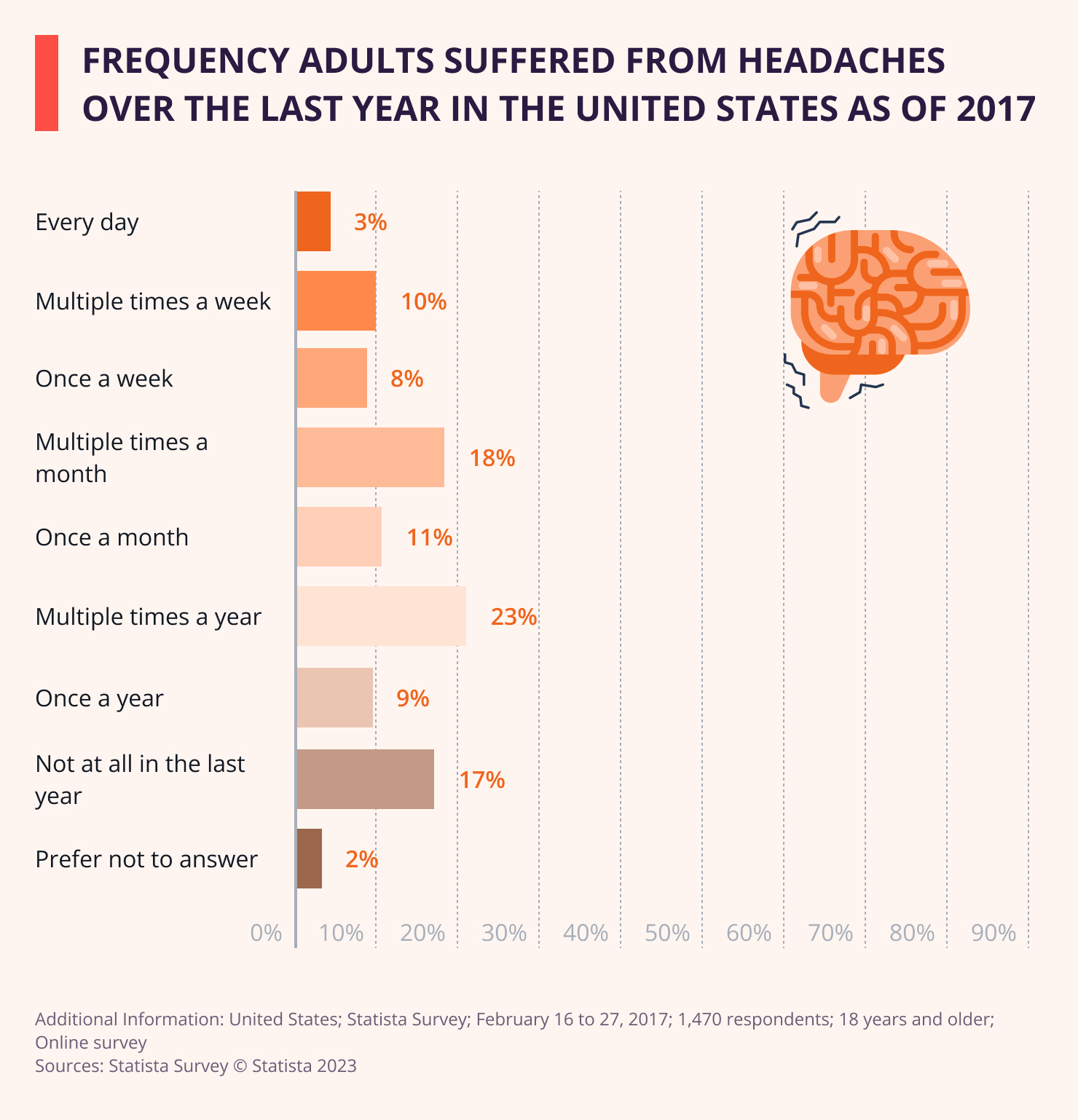
According to a 2017 survey of 1470 participants in the United States[2]:
- 39% of the respondents had a headache more than multiple times per month.
- 23% of respondents claimed to have a headache multiple times a year.
- 17% claimed that they had not suffered from a headache at all in the last year.
By Age
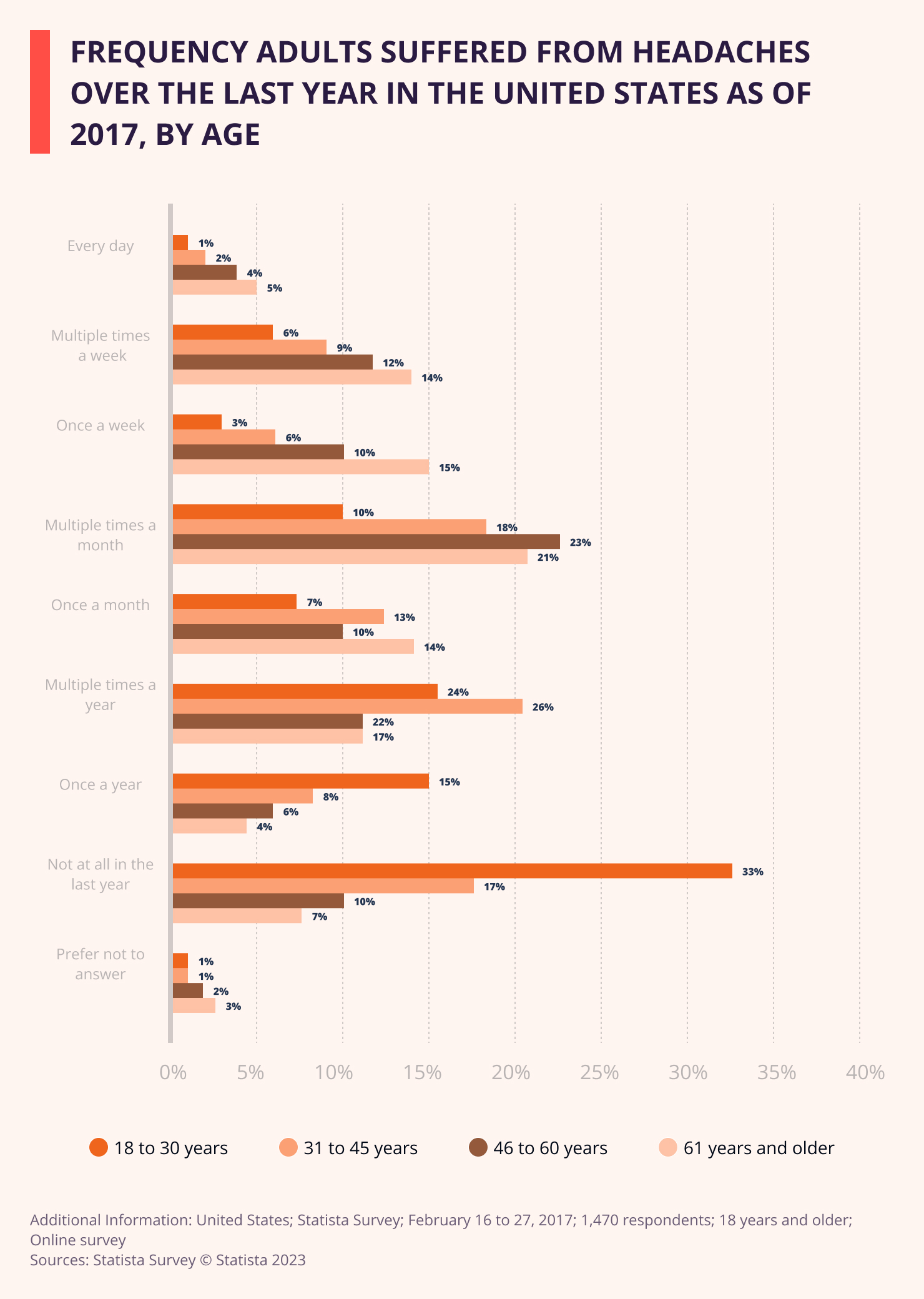
When examining the age breakdown of the respondents and their correlation to headaches, it was evident that those who were 61 years of age or older had the highest percentage of those who had no head pain at all last year, at 33%[3].
- 15% of respondents who suffered from headache symptoms once per year were 61 years of age or older.
- Of respondents who claimed to have headaches occur at least once a week or more, 34% were 18 to 30 years old.
- Of respondents who claimed to have head pain multiple times per month, 23% were 31 to 45 years old, and 21% were 18-30 years old.
By Gender
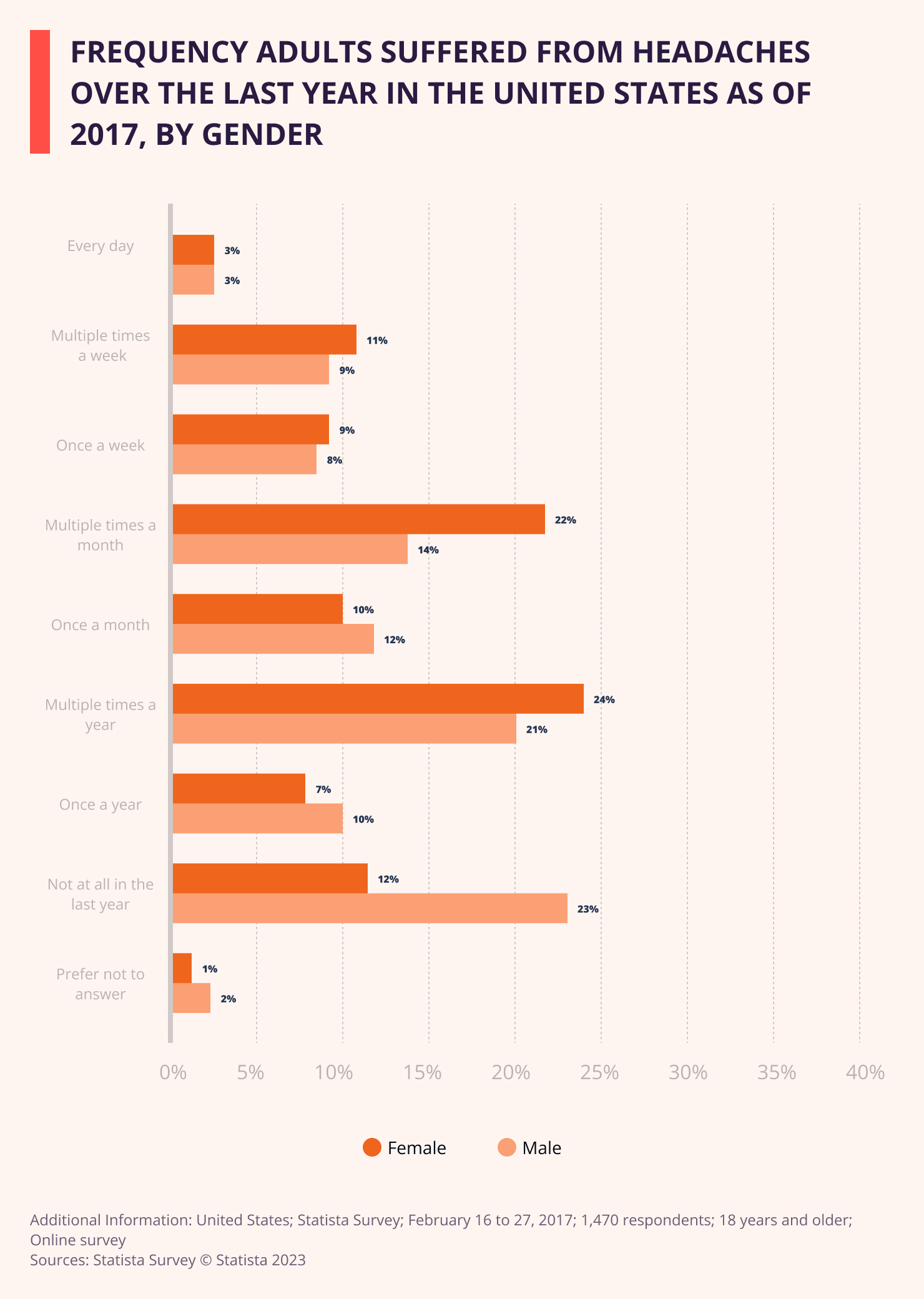
Among multiple headache frequencies, females tend to have more headaches than males[4].
- 23% of females suffer from headaches one time or more per week.
- 22% of females have headaches that occur multiple times per month.
- 24% of females have headaches multiple times per year, while 23% of males did not have any headache pain at all last year.
Ways U.S. People Relieved Headaches
By Age
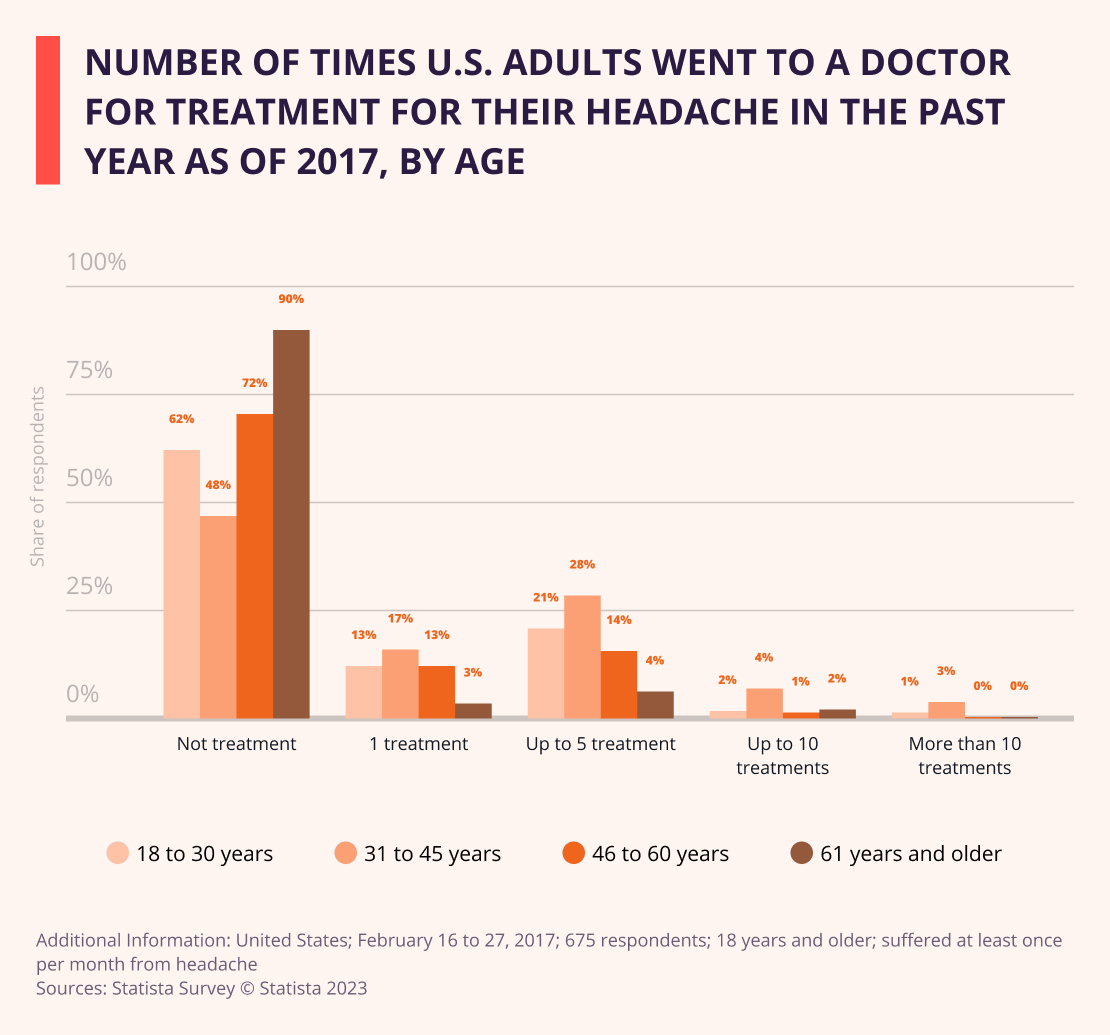
Treatment for frequent headaches varies by age.
- 90%[5] of those who are 61 years and older did not seek a doctor for treatment of their headache.
- 72% of people who are 46 to 60 years old did not seek a doctor for treatment of their primary headache.
- 28% of those who are 31 to 45 years of age obtained up to 5 treatments from a doctor.
- 34% of those who are 18 to 30 years of age had their headaches treated 1 to 5 by a doctor in the past year.
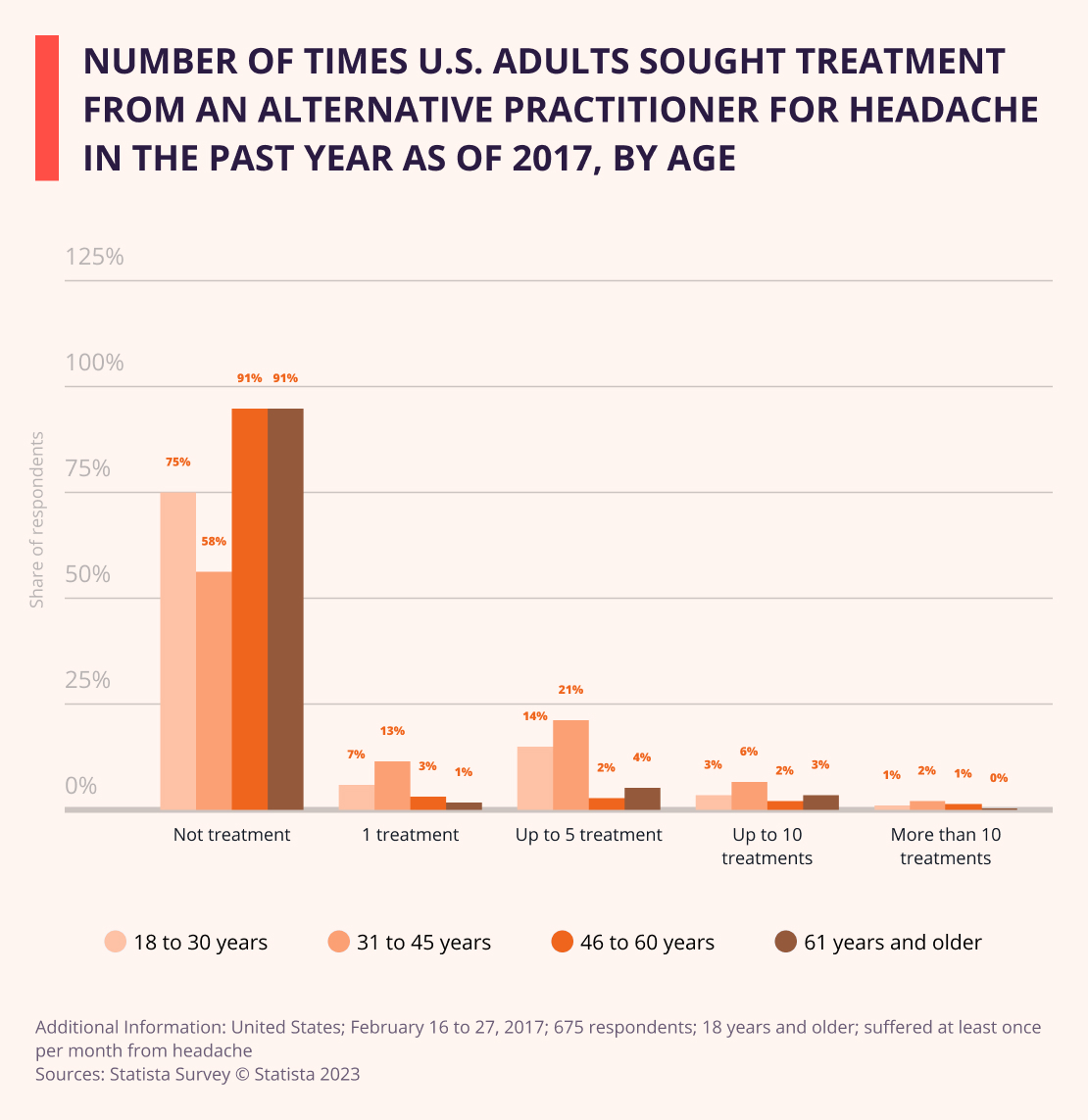
Seeking treatment from alternative practitioners such as headache specialists or those who practice Eastern medicine is not very common in the United States for those suffering from chronic headaches.
- 91%[6] of those who are 46 years or older did not seek treatment from alternative practitioners.
- 40% of those who are 31 to 45 years old seem to be more receptive to alternative practitioners to get their primary headaches treated by seeking one or more treatments.
- 24% of those who are 18-30 years old sought treatment from an alternative practitioner.
By Gender
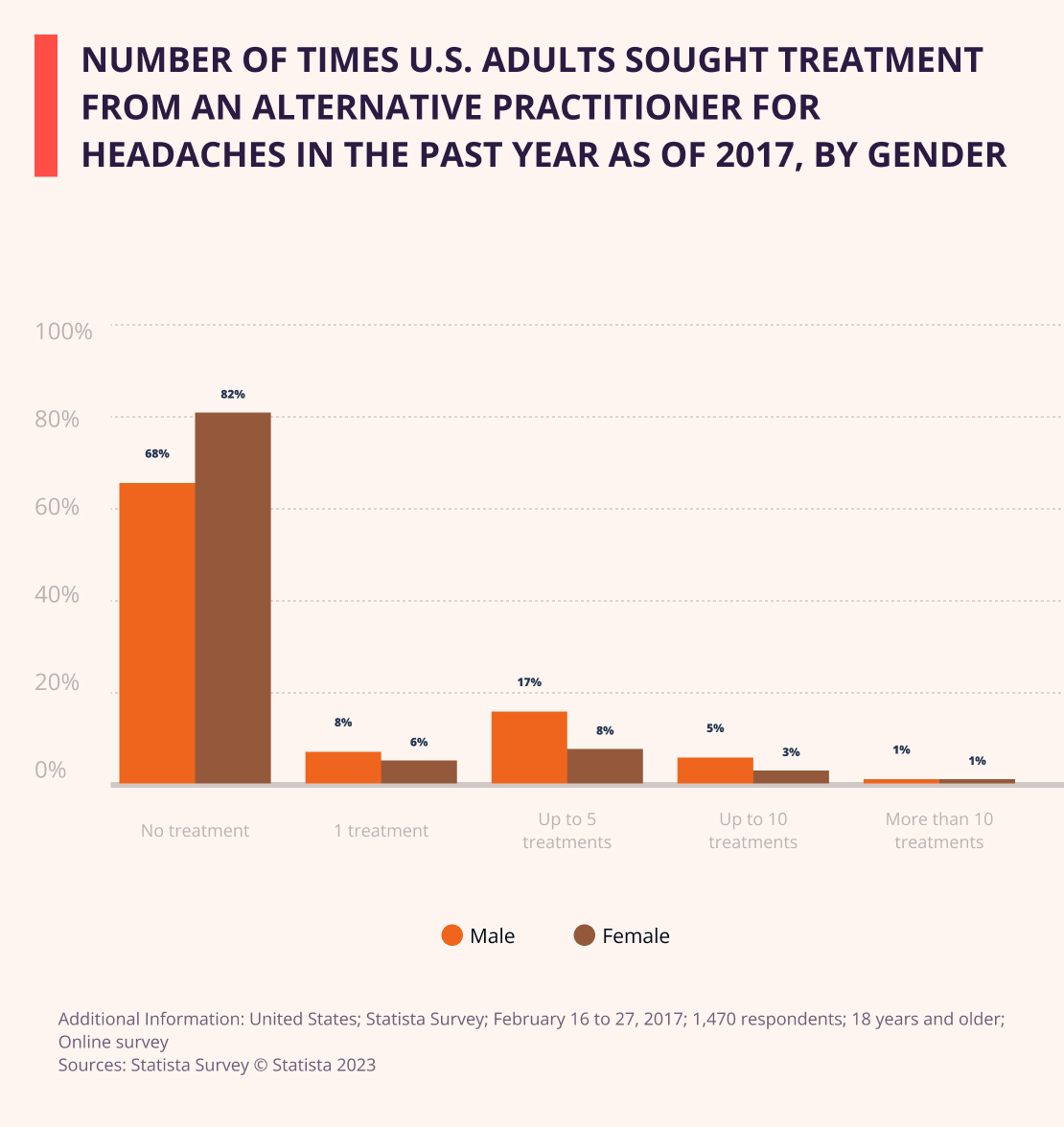
The gender that seems to be more open to seeking out alternative practitioners for their headaches tends to be men.
- 30%[7] of men obtained treatment from an alternative practitioner versus 17% of women.
- 82% of women avoided treatment from an alternative practitioner.
Causes Of Headaches In The US

Emotional stress seems to be the most common trigger for most headaches, according to a 2017 survey[8].
- 62% of respondents believed that stress is predominant in their headache triggers.
- 30% of respondents believed that screen time was the main cause of headaches for them.
By Age
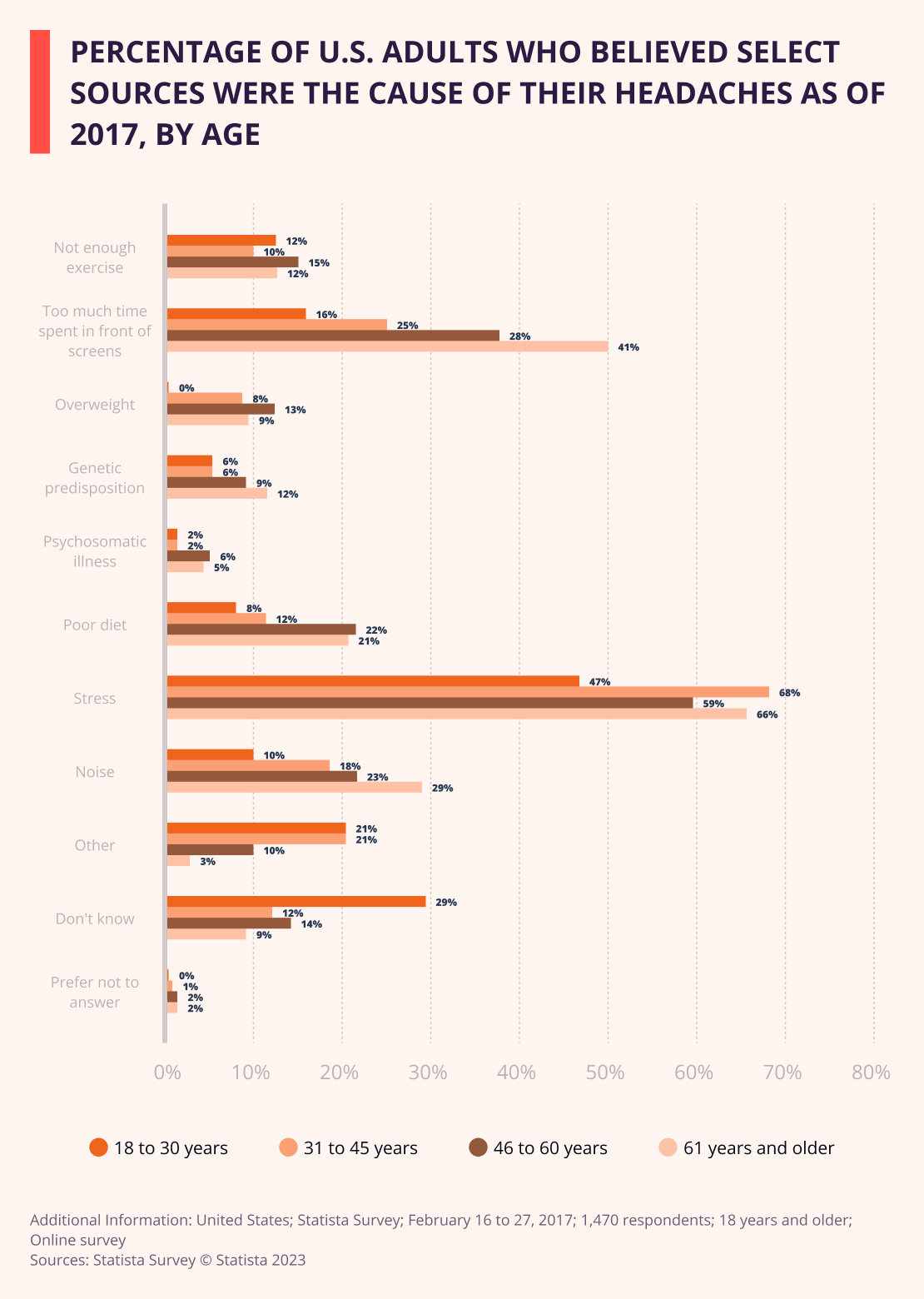
Stress is the predominant contributor to headaches among all the age groups surveyed[9].
- Those who are 18 to 30 years old believe that headaches are predominantly caused by stress, then by screen time, and then followed by noise.
By Gender
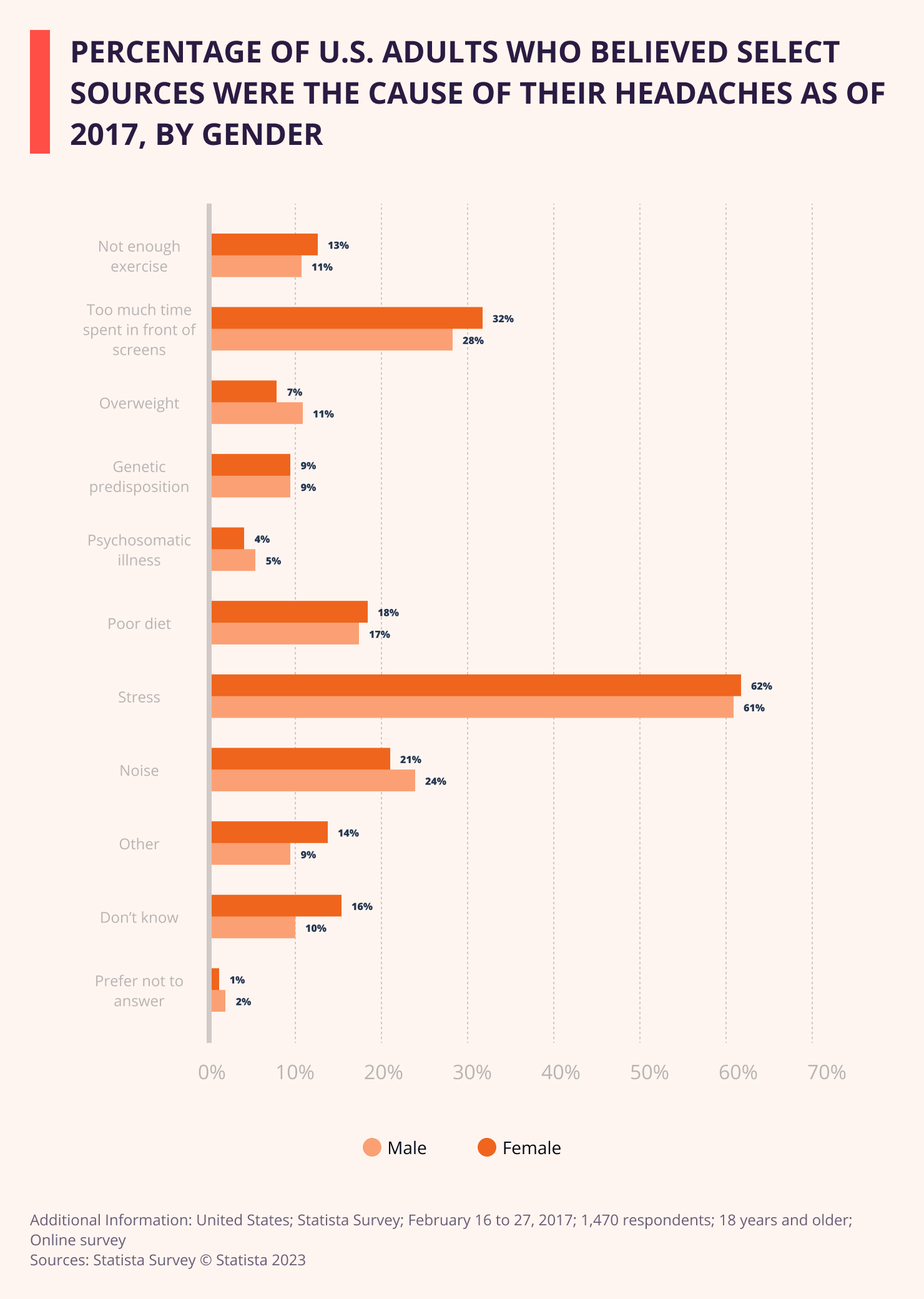
Both genders also believe that headaches occur most often due to stress.
- 61% of males and 62% of females believe that stress is the cause of why their headaches occur[10].
- Males and females are also within the same belief that lack of exercise and poor diet can be a cause of headaches.
- A higher number of males believe that screen time causes headaches than females, while a higher number of females than males believe that noise can be a contributor.
Types Of Popular Headaches In The US
Migraines
- Based on a 2011 review[11], Migraines make up 61% of all headaches that are treated within primary care and neurologist offices.
- Migraine is a debilitating neurological ailment that affects more than 1 billion people worldwide[12].
- The prevalence and burden of self-reported migraine and severe headaches in the US adult population are high, affecting roughly 1 out of every 6 Americans and 1 in 5 women over 3 months[13].
- As of that time, 94%[14] of respondents diagnosed with migraine agreed that migraine headaches are different from other headaches.
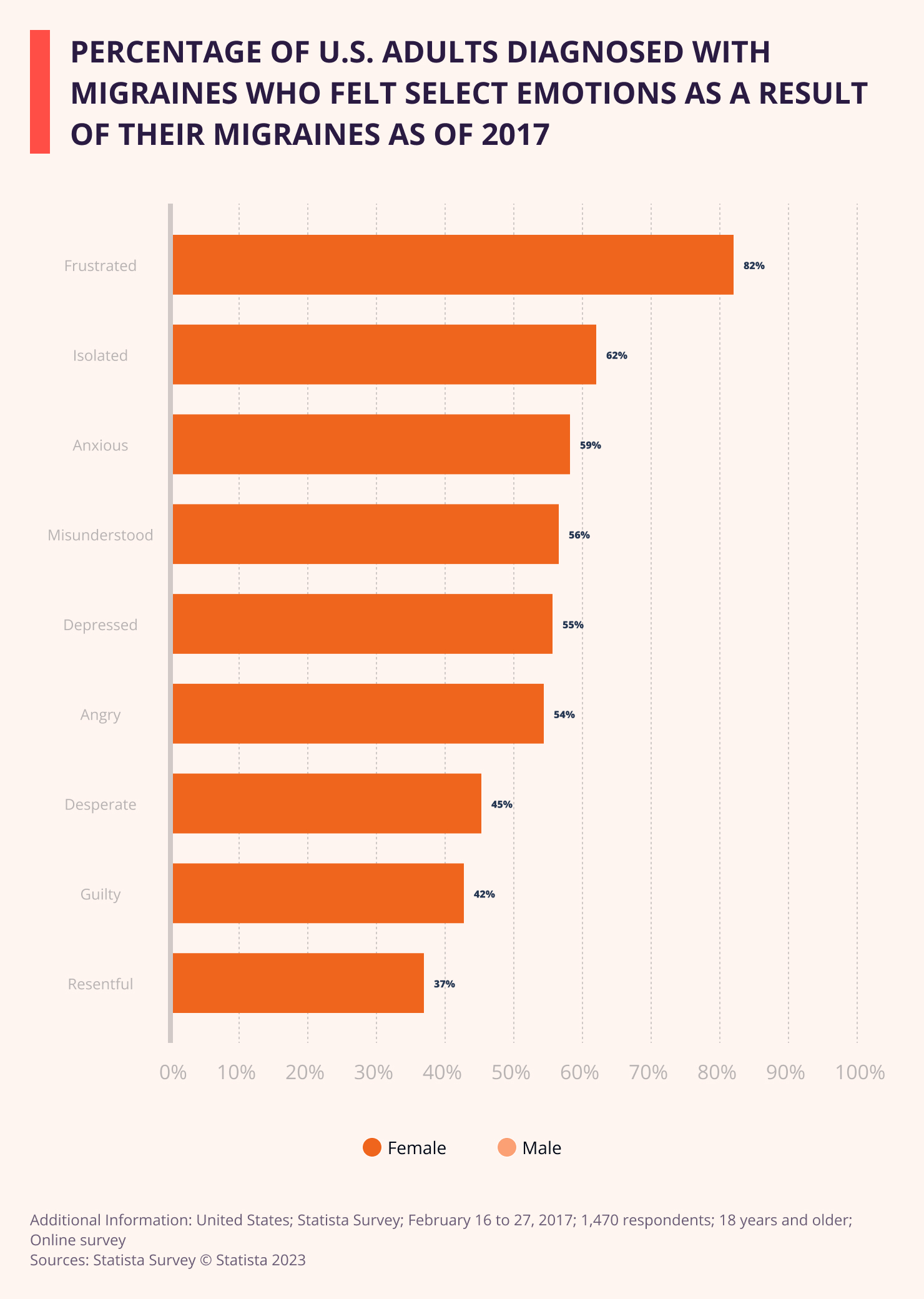
Migraines affected US adults’ emotions as of 2017[15]:
- 82% of respondents felt frustrated as a result of their migraines.
- 62% of respondents felt isolated as a result of their migraines.
- Only 37% of respondents felt resentful as a result of their migraines.
Symptoms
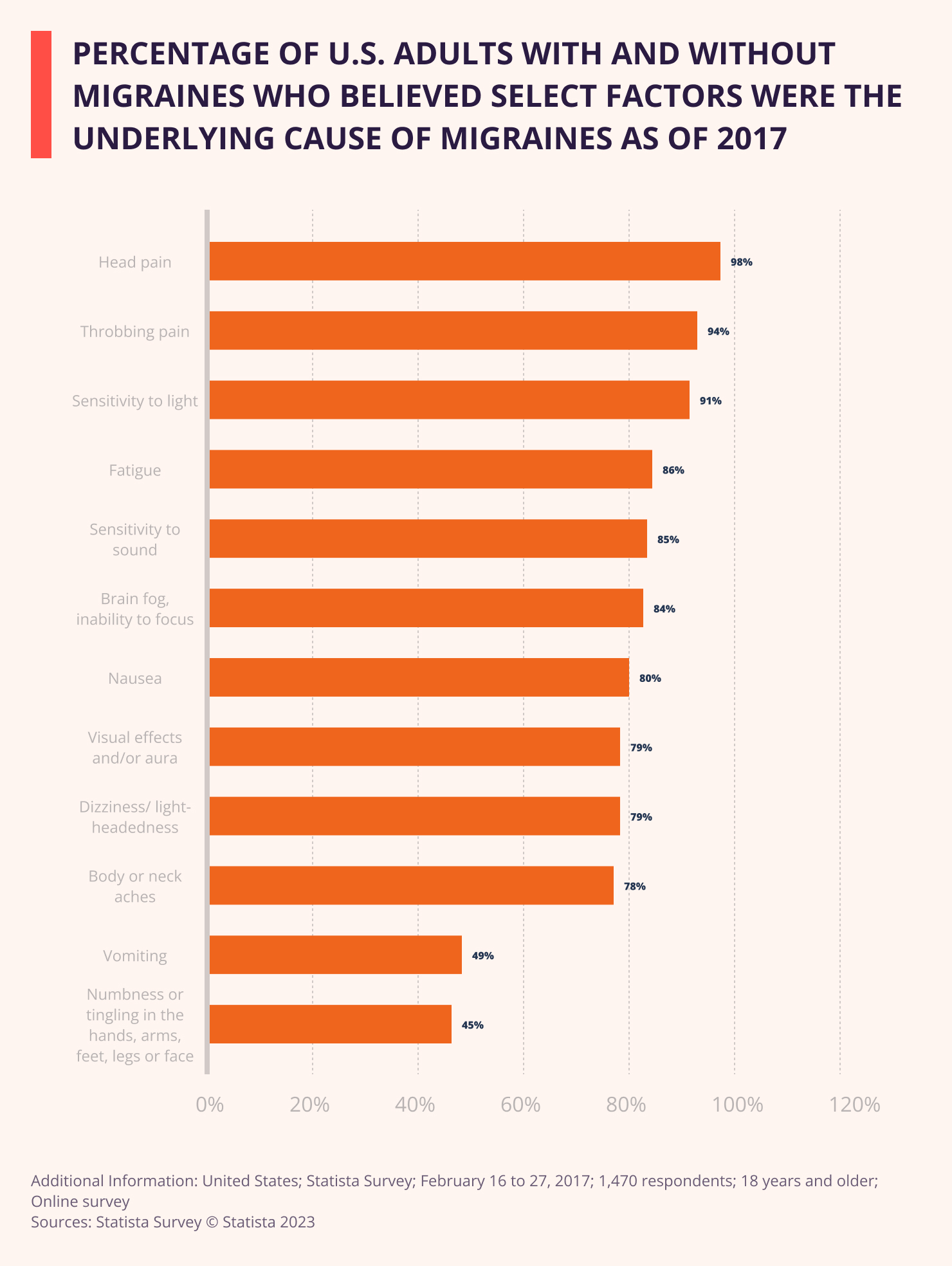
- Head pain tends to be the most predominant migraine symptom with 98% of respondents[16].
- 91% reported to have a sensitivity to light.
- 80% reported to have nausea, and 49% reported vomiting.
- The last reported symptom was numbness and tingling in the hands, arms, and feet.
Causes
Of those who are migraine sufferers:
- 38%[17] believe that there are biological causes for their migraines.
- 28% believe that lifestyle and habit play a role in their migraine cause.
- 34% believe that the cause of a migraine is unknown.
Of those not diagnosed with migraines:
- 35% of those not diagnosed with migraines believe that migraines have a biological cause.
- 30% of those who know someone with migraines believe that migraines can be caused by lifestyle.
Treatments
There is a wide range of migraine headache treatments[18]:
- Pain medications to decrease pain signals (Over the counter and prescription)
- Medications that prevent symptoms of a migraine headache such as sensitivity to light and nausea
- Blood pressure medication to prevent high blood pressure
- Seizure medication to treat migraines
- Lifestyle changes such as improving hydration and diet
- Stress management such as meditation and yoga
- Alternative medicine such as acupuncture
Cluster Headache (CH)
It is a form of headache that tends to occur in clusters of time in the same location, lasting roughly 1 to 3 hours.
- Males tend to have higher rates of cluster headaches beginning at the age of 30[19].
- Affects 1 out of every 1000 people.
- Tends to run in the family[20], and therefore, knowledge of the family’s underlying medical condition is important.
- Less common than a chronic migraine.
Symptoms
- Sudden severe pain that can be sharp, stabbing, or steady.
- Neurological symptoms occur at the same time of day.
- Throbbing pain on one side of the head from the neck to the temple with eye involvement.
- Extremely painful headache within 5 to 10 minutes and can last up to 2 hours.
Causes
- Heat.
- Foods high in nitrates (preserved meats).
- Change to high altitudes.
- Alcohol consumption and smoking.
- Bright lights.
- Physical exertion.
Treatments
- During the time of severe headaches, high-dose oxygen therapy via a face mask and a nasal spray constricts the brain blood vessels to dull the pain.
- To prevent other cluster headache medications such as steroids, lithium, and vasodilators consulting a doctor is essential.
Tension Headaches
Tension headache is the most common type of headache, with muscle tightness and squeezing in either the neck, head, or scalp. They can occur during a migraine and can trigger headaches.
- Chronic daily headaches occur fewer than 15 days per month and are reported by more than 70%[21] of the population.
- 1 to 3% of adults tend to have more than 15 days of tension headaches per month.
Symptoms
- Dull ache.
- A tight band around the head.
- Moderate pain all over the head.
Causes
- Muscle contractions due to stress, depression, anxiety, or head injury.
- Alcohol use and excessive smoking.
- Sinus infection or colds.
- Poor posture and muscle tension.
- Eye strain.
- Dental issues.
Treatments
- Massages of the affected area tend to assist with relieving symptoms.
- Muscle relaxers.
- Pain medication for dull pain.
- Ice packs for the sides of the head.
Conclusion
Through the examination of headaches and migraines statistics within the United States, it is evident that there are various forms, perceptions, and population groups affected. It was discovered that what causes headaches predominantly is stress. The notion of how symptoms are treated varies among age groups.
Women tend to have higher rates of headaches, yet men tend to seek alternative ways of coping with the headaches and other symptoms. It was discovered that migraines tend to be the most common form of headache diagnosed within the healthcare system and that they cause frustration, isolation, and anxiety among sufferers.
Author Information
Yelena Wheeler
Health Writer
Media Contact
Erik Pham
Founder of Health Canal
[email protected]